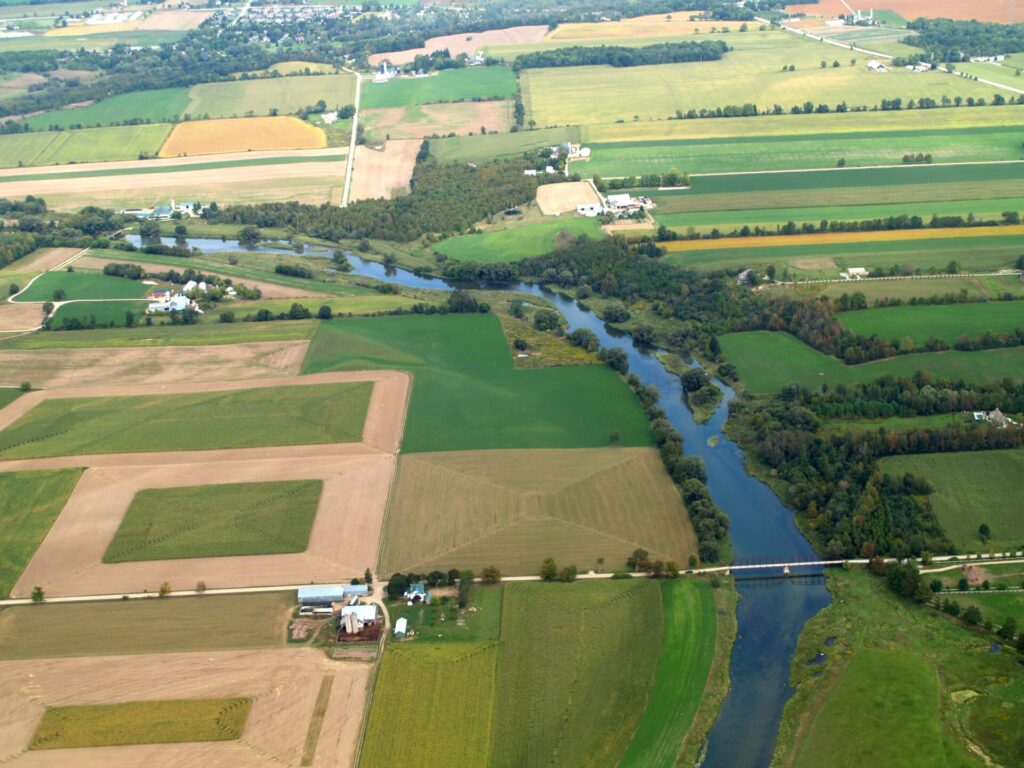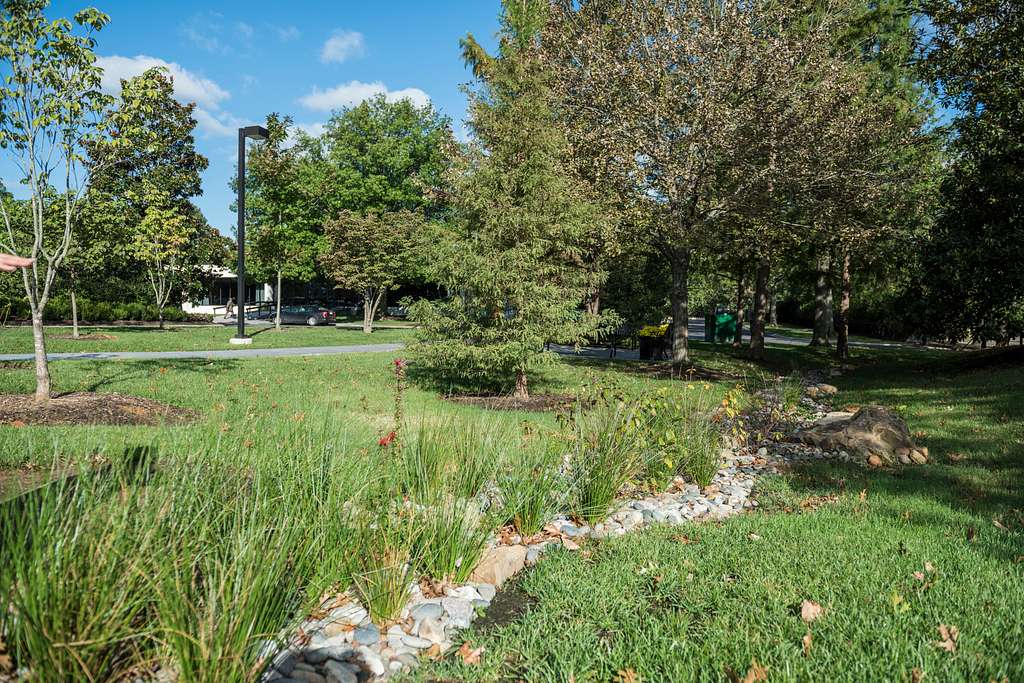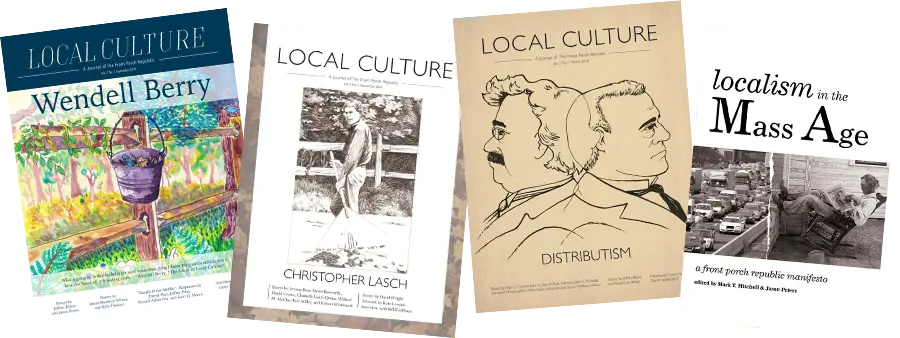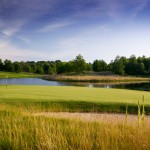The Grand River ambles lazily through its shallow valley, meandering westward through Grand Rapids toward the blue sweep of Lake Michigan. The countryside in between lies like a verdant quilt stitched together from farm fields, embroidered with hedgerows, and dotted with small towns. Creeks and streams trickle across the patchwork, lacing under roads and across pastures. Greenhouses march in neat rows, bordered by nursery plants in deeper hues—junipers, maples, and yews standing like sentinels in the sun.

It hardly seems the sort of place to suffer a water problem.
But wells are running dry. Drinking water grows salty. Irrigated fields bloom with brown-edged warning signs. In quiet Ottawa County, Michigan, a water crisis is not merely brewing—it is already here.
When the troubles first appeared, the county did what we moderns tend to do: consulted the experts. Studies were commissioned, meetings were convened. The problem, it turns out, lies deep beneath the surface, in the geology of the place itself.
The primary bedrock aquifer—the Marshall Formation—is capped by a layer of impermeable clay. This means the aquifer recharges far more slowly than it is being drained.
To complicate matters, Michigan was once covered by a shallow inland sea. It’s the reason tourists still comb northern beaches for Petoskey stones, those fossilized corals polished smooth by time. That ancient sea now sits deep below the bedrock—and the freshwater aquifer floats precariously atop it. But when too much water is pulled too quickly, the boundary between fresh and salt begins to erode, and ancient seawater wells upward into the aquifer. Irrigating crops with this brackish water amounts to salting our own fields.
The Marshall Formation isn’t the only available source of groundwater. In a region blessed with abundant rain and surface water, it’s not surprising that shallower glacial aquifers also pocket the landscape. But “shallow” often means “unfiltered”—those waters haven’t percolated through deep layers of sand and limestone. They are vulnerable to contamination: nitrates from fertilizer runoff, phosphates, and even PFAS, the stubborn “forever chemicals.”
Naturally, there has been a fair amount of finger-pointing about who is to blame—and who must sacrifice to fix the problem. In a county that has been touting “50% growth” in the next decade, while remaining home to both a sprawling greenhouse industry and conventional agriculture, the real answer is painfully simple: Everyone.
Is the problem irrigation? Yes—but not always in the way one might expect.
Those huge center-pivot irrigation systems in farm fields seem like the obvious culprits. But the total water use from those systems—many of which draw from shallow aquifers unsuitable for drinking—pales in comparison to the water drawn by all the new subdivisions with their underground sprinkling systems. We’re watering lawns far more than we’re watering crops.
All those new houses also increase the draw for everyday needs: drinking, bathing, laundry. Meanwhile, agricultural use continues, much as it always has. Every drop withdrawn from the deep aquifer is another drop that isn’t being replaced, no matter its purpose.
Farms and lawns also share the blame for surface water contamination. Fertilizers dumped on both—often in excess of anything the soil could ever require—simply run off into ditches, creeks, and fields. And from there, they seep straight into the shallow aquifer.
The knee-jerk reaction to all of this in our cultural moment is, “somebody should do something about that!” And, indeed, somebody should. But which somebody? Where, in the hierarchy of subsidiarity, does the responsibility lie?
The knee-jerk reaction to all of this in our cultural moment is, “somebody should do something about that!” And, indeed, somebody should. But which somebody? Where, in the hierarchy of subsidiarity, does the responsibility lie?
Allendale Township has extended its municipal water system to one of the developments whose wells ran dry and has instituted a zoning requirement that all new developments must also be supplied by this system—no more individual wells. Robinson Township has had to supply its elementary school with bottled water until they can work out how to deal with its PFAS-contaminated well.
Two tiny townships can’t do much about a county-wide problem. And the county, predictably, is responding with educational videos and commissions to study the problem some more. Even if the county does begin to make practical changes, the Marshall Formation doesn’t begin and end at the county line.
As yet, our neighbors in adjoining counties have taken little notice. Although they haven’t documented problems yet, water seeks its own level. This happens even under bedrock; it just takes longer.
Nor is our geologic anomaly unique to one tiny corner of West Michigan. The same conditions exist in the counties bordering the Saginaw Bay—and likely elsewhere within the Great Lakes Basin.
Do we count on the state to save us? Some new program from the federal government?
Do we really think that if we grumble enough, an Official Moses will appear to strike the rock and bring forth water in abundance? Does it make sense to look for a miracle rather than to attempt to live within the limits of Creation in this place?
If we are to live within the limits of the land—not merely in this one corner of Michigan, but more broadly—we must begin rethinking both our assumptions and our habits.
And that begins with the patch of ground right outside our doors. It’s there that the shift needs to begin. The farm store had a pallet of fertilizer bags just inside its doors that epitomized the modern assumption. Emblazoned on the side of the box was, “Everyone deserves an Estate lawn!”
But should suburbia really be tiny imitations of the Shades of Pemberley, lined up in neat, unnaturally green rows? While a man’s home might be his castle, or even country manor, this type of trickle-down ostentation serves no practical purpose. And yet it has become so much a part of the mythology of American life that the state of lawns is frequently dictated by HOAs and local ordinance.
Why is every lawn in Michigan comprised of blends of Kentucky Bluegrass and Tall Fescue? Why not native species, which are more drought-tolerant and better suited to the climate? Some require little to no watering, and even little to no mowing. Now, your lawn won’t look like the plush green velvet of a Major League Baseball infield, but it will cover the ground, preventing weeds and offering a soft turf for walking or even a game of touch football. It might even increase your chances of watching fireflies on summer evenings, in your own backyard.
Then, having planted a healthy lawn of native grasses, it seems only fitting to turn to the rest of the landscape. Choosing species that thrive without fuss will make a landscape that is both beautiful and less inclined to eat up your weekends with upkeep. On top of that, it’s likely to attract more birds, butterflies, and other visitors to your garden.
Real change will not come merely from rule books. It must grow from a deeper change in posture—a shift from consumption to care. From treating our land as a trophy and a display of our prosperity to our neighbors, to viewing it as a trust. A well-designed landscape will build the soil and function as part of the larger environment rather than an island of artificiality in the middle of it.
The same spirit of stewardship must take root in our fields as well as our yards. Conventional agriculture depletes topsoil, contributes to contamination of surface water and shallow aquifers, and contributes to run-off into local streams and rivers. The soil itself, to quote Ray Archuleta, is “hungry, thirsty, and has a fever.” But the practice continues because it’s difficult and frightening to make such a major change that goes against “how things are done.” However, if we will not be ruled by wisdom, we will be ruled by scarcity. And that is coming.
Regenerative farming practices—not just “no till”—address these issues by keeping cover crops on the soil at all times, planting crops that are suited to the environment, and often adding livestock into the rotation to help rebuild soils. They may require more human labor, but a well-managed regenerative farm uses little or no herbicides or fertilizers because it doesn’t need them. And as soils are rebuilt, their water infiltration improves. Which means that runoff and contamination cease to be problems. And make no mistake, they are problems, even in the face of rainfall totals that our neighbors on the high prairie gaze upon with undisguised envy.
But even if we tend our lawns and heal our soils, we cannot ignore the deeper structural problem: the pattern of growth itself. A county already experiencing water problems related to increasing usage cannot sustain a 50% growth rate. And the difficulties created by how we grow are not limited to places with known water challenges.
It may be time to admit that the “suburban experiment” has, in many ways, failed to live up to its promise. It’s left us trapped in a pyramid scheme of “growth” that continually kicks the can of infrastructure costs onto the next big project. The folks at Strong Towns have done the math, and it’s clear: we cannot continue in the way we’ve been going for all of my lifetime.
It’s a hard truth to talk about—but a vital one.
Ask a dozen different “urban planning” experts what the solution is and you’ll get a dozen different answers. The right one probably involves neither eliminating zoning regulations entirely nor making them so strict that nothing can be built at all. But zoning reform, unhindered by “helpful” lawyers and consultants paid by national developers or organizations with their own hobby horse, might help start addressing the mess. Perhaps we need fewer commercial districts replete with strip malls and more local business actually located in the neighborhoods they serve. Fewer Taco Johns and more mom-and-pop diners. Resist the urge to court major “development” projects in favor of encouraging local, small scale changes. The goal is functioning communities rather than adjacent but isolated pods.
A better pattern of growth would knit homes, farms, and businesses into living communities, not scatter them like debris across the countryside. Suburban-style three-car garage homes on 2 acre lots entirely given over to lawn epitomize the worst excesses of both suburban development and rural independence. Abundance, rightly understood, is not merely the having, but the nurturing of the legacy of that land. In this case, we might do well to ask not what we can possess, but what we are willing to tend.
Finally, true local stewardship must be freed from the web of well-meaning but paralyzing regulations. Well-intentioned “agricultural preservation” programs make it difficult and cost-prohibitive to turn a former piece of a conventional farm owned by an agribusiness conglomerate into a working home and farmstead, regardless of how much better for the community such a thing might be.

Likewise, many old techniques for conserving and making use of surface water could be put to use. But overenthusiastic enforcement of regulation and overbroad definitions of “wetlands” make many landowners wary of using swales, cisterns, or stock ponds to reduce their need to draw on groundwater supplies. This is one instance in which addressing things at the state or even federal level makes a certain degree of sense. Remove the barriers to local management if you truly want to improve water resource resilience.
To live within the limits of Creation is not a punishment, but an invitation — to belong, to tend, to thrive.
Dominion was given to us, but not as a license to take and waste. We were not made viceroys and vicereines, but keepers and kin.
The Hebrew word radah may yet teach us: it means not to rule as tyrants, but to stand at the center as a strength — to nurture, to uphold, to bless.
It is not ours to conquer, but to cherish; not ours to spend, but to sustain.
Water is life. How we treat our water reveals how we understand our place in Creation.
Image: Grand River via Wikimedia






1 comment
Stephen
“Trickle-down ostentation” — a wonderful turn of phrase.
Comments are closed.